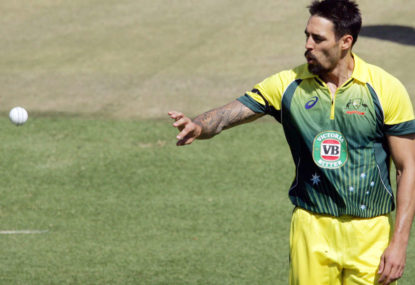There’s been a flood of breathless commentary following Australia and New Zealand’s low-scoring thriller, and most of it has focused on the fact that neither side had a good day.
But that happens in cricket. Both teams have been in phenomenal form and this was their first slip up in quite some time. Fortunately for New Zealand, they still managed to triumph.
Fortunately for Australia, it was not a knockout game.
There’s a long way to go in this tournament and, by the time the final arrives, the events of this game largely will be irrelevant. So calm down for a moment and let’s examine some of the most common knee-jerk reactions to this thriller in Auckland.
Australia’s batsmen are clueless against quality bowling
Well, few batsmen in the world are at ease when an opposition bowler or attack is on song but many modern day batsmen are ill equipped to counter canny swing bowling. We saw as much when Mitchell Starc started uprooting poles like a tornado.
The suggestion that Australia’s batting line-up flounders when confronted with potent pace or swing bowling is an exaggerated one. Every line-up struggles in such a scenario and recent results would suggest Australia do so less than most sides.
South Africa’s pace attack arguably is the best in ODI cricket. Yet Australia’s batting unit flourished against them during the five-match ODI series down under in November.
They chased down scores of 275 and 268 without major troubles and posted totals of 300 or more two of the three times they batted first.
Their one hiccup was being skittled for 154 batting first when Morne Morkel and Dale Steyn fired up on a bouncy WACA track, taking a combined 8-56. When you’re playing sides with attacks as dangerous as South Africa’s or New Zealand’s, sometimes you will get rolled cheaply.
Australia’s batting against the Kiwis was woeful, mind you, with many of their dismissals the result of poor shots. But that happens from time to time. Even the best teams have shockers.
Don’t forget, this is an Aussie side which had won 12 of its past 13 completed ODIs, including a 5-1 win-loss record against the number two and three ranked sides in India and South Africa.
New Zealand relies too heavily on McCullum and Williamson
There have been plenty of claims that New Zealand’s batting is vulnerable outside of this in-form pair, that when the pressure rises the others fold. Were Saturday’s game the first time you’d seen the Kiwis play, then this would be a logical conclusion.
The rest of the New Zealand order collapsed. Again, though, bear in mind the quality of the opposition or, more specifically, the menace of Starc’s merciless yorkers. The lanky left armer now is as good as any bowler in ODI cricket.
New Zealand’s batting has been a major weapon for more than 12 months. Against all manner of attacks, in a variety of conditions, their batsmen have made merry.
Did Australia expose a weakness? Who knows?
It’s the first time the Kiwis have fallen apart like that in a good while and it’s also the first time these two sides have even played each other in two years. And that last encounter, in the Champions Trophy in 2013, ended as a washout, with the Kiwis facing just 15 overs in the second innings.
It’s too early to make any calls on the fragility, or otherwise, of New Zealand’s batting beyond the commanding Williamson and McCullum.
Mitchell Johnson is becoming a liability
Johnson’s performance was another thing to toss in the ‘shit happens’ bin, along with the batting efforts of both sides.
Granted, over the past nine months Johnson has not been as swift, as menacing or as effective as he was in the summer of 2013-14. But neither has anyone in world cricket – even before that, arguably.
It was as freakish a sequence of cricketing performances as you will likely witness in the span of your life.
Johnson’s bowling against New Zealand stank, it was rank, and for the Kiwis it was runs in the bank.
In this current age where teams can score 249 runs from their final 18 overs like South Africa did against the Windies, a bowler’s off day can quickly turn catastrophic.
Run into a de Villiers, a Gayle, a Kohli or a McCullum under the wrong circumstances and you can be showered in the proverbial. In fact, even a good day now can turn horrific in half an hour for bowlers.
The prosecution: “Calling to the witness stand, West Indies captain Jason Holder. Mr Holder, please relay to the jury the figures you held after bowling five overs against South Africa”.
Mr Holder: “One for nine, sir”.
The prosecution: “And from your final five overs, Mr Holder?”
Mr Holder: “You don’t understand, the bats these days are…”.
The prosecution: “Answer the question Mr Holder”.
Mr Holder: “0 for 95”.
The prosecution: “And there you have it, good people of the jury”.
Bowlers increasingly are cannon fodder in ODI cricket and should not be written off based on the occasional shocker. In Johnson’s previous six outings for Australia, he’d snared 11 wickets at 19.
He is a match winner. He can also be expensive. But so can every bowler, no matter how gifted, in this modern age of ODIs. Like the batting line-ups of Australia and New Zealand, don’t condemn Johnson based on one match.





























































































